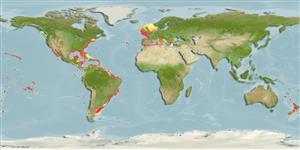Common names from other countries
Environment: milieu / climate zone / depth range / distribution range
Écologie
; saumâtre; profondeur 0 - 220 m (Ref. 116114). Tropical
Atlantic, Caribbean and Indo-Pacific Oceans in tropical and subtropical climates.
Length at first maturity / Taille / Poids / Âge
Maturity: Lm ? range ? - ? cm Max length : 0.5 cm WD mâle / non sexé; (Ref. 2992)
Epipelagic (Ref. 116114). Known from mangroves (Ref. 86642). Found in patch reefs, mangrove island, sand trough areas, outer ridge and fore-reef slope on substrates composed of algae, mangrove roots or dead corals and gorgonians. In Belize, it is found at depths of 0.2 to 31 m. As with other hydroids, this species exhibits a pelagic medusoid stage.
Life cycle and mating behavior
Maturité | Reproduction | Frai | Œufs | Fécondité | Larves
Species exhibits both asexual and sexual reproduction by budding during hydroid stage and release of gametes in medusae stages (Ref. 1663, p. 15). Period of reproductive maturity recorded for Carrie Bow Cay, Belize is from 17th to 25th May, during which the samples collected had gonophores or medusa buds
Migotto, A.E., A.C. Marques, A.C. Morandini and F.L. da Silveira. 2002. (Ref. 813)
Statut dans la liste rouge de l'IUCN (Ref. 130435)
statut CITES (Ref. 108899)
Not Evaluated
Not Evaluated
Utilisations par l'homme
| FishSource |
Outils
Plus d'informations
Taille/ÂgeCroissanceLongueur-poidsLongueur-longueurMorphologieLarvesAbondance
Sources Internet
Estimates based on models
Preferred temperature
(Ref.
115969): 11.5 - 28, mean 23.1 (based on 2116 cells).
Vulnérabilité
Low vulnerability (10 of 100).
Catégorie de prix
Unknown.
